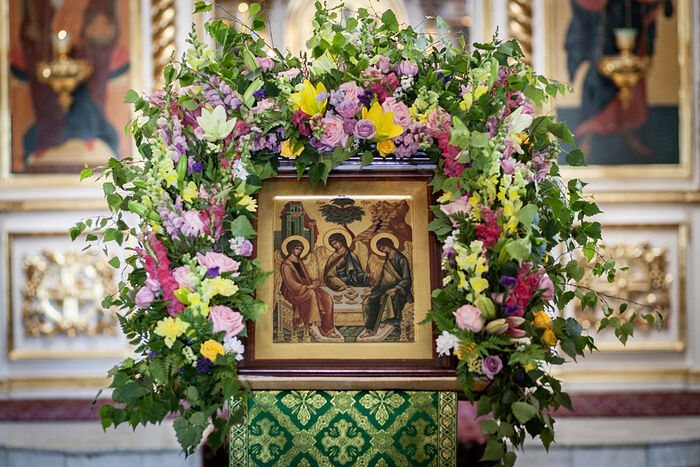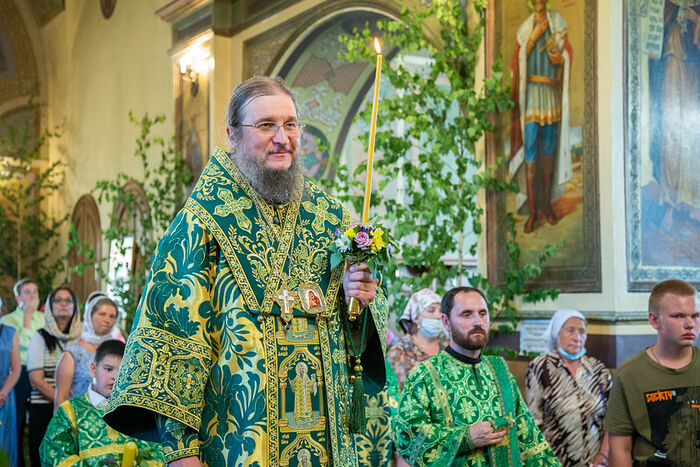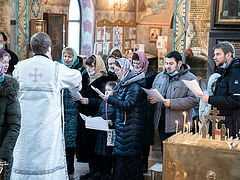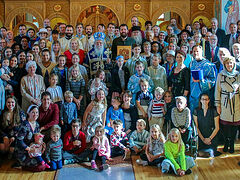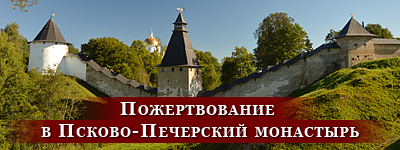The feast of Pentecost has various adornments. Lofty theology, unusual worship, the long-awaited prayer, “O Heavenly King”, sung on this day as if for the first time in life. And then, the verdancy of our beloved birch trees, freshly cut grass, a variety of field and garden flowers. It’s no coincidence that our ancestors called Holy Trinity week a “Green Christmastide.”
Our common cause of flower arrangement
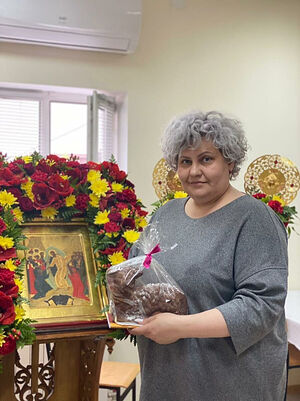 Julia Ivanovna Tsygankova Bishop Pachomy of Pokrovsk and Novouzensk called Pentecost the “Day of the Orthodox Florist.” “I fully agree and always try to take part in the decoration of a church on this day,” says Julia Ivanovna Tsygankova, head instructor at the florist courses of the Pokrovsk Diocesan Educational Center. A successful master of her craft and the owner of several florist shops, she has been teaching, for the last seven years, anyone interested to make a positive contribution to this beautiful and fragrant activity.
Julia Ivanovna Tsygankova Bishop Pachomy of Pokrovsk and Novouzensk called Pentecost the “Day of the Orthodox Florist.” “I fully agree and always try to take part in the decoration of a church on this day,” says Julia Ivanovna Tsygankova, head instructor at the florist courses of the Pokrovsk Diocesan Educational Center. A successful master of her craft and the owner of several florist shops, she has been teaching, for the last seven years, anyone interested to make a positive contribution to this beautiful and fragrant activity.
A church floral designer of many years, she puts her heart and soul into every project. When asked, “What does this work give you personally?” she would answer, “It is another way to have a conversation with God.” No more and no less. The Lord gradually reveals Himself to her, a sincere and genuine teacher, who in response to the frank question, “Don’t you regret sharing your trade secrets with others?” she straightforwardly replies: “The more capable students I get, the more joy it brings. It means my life’s work will live on.”
Flower décor, as another method of serving the Lord and the Church, is also used as an educational tool
Besides, flower décor, as another method to serve the Lord and the Church, is also used as an educational tool. “You are not here to show off your skills. The most important thing for you is to learn humility.” Wouldn’t you agree that it is unusual to hear such a comment from a self-described secular florist? But those are exactly the words we heard when we got into a little argument during our flower décor session as to who was the best at it. “You have to see what others are doing and learn to work as a team. You're working to achieve a common goal,” our teacher admonished us. Over the years, we indeed developed a team, and not just one but a few of them. The course graduates consider the job of decorating their parish church a matter of strategic personal interest, as they rejoice at having the opportunity to serve the Lord with their newly discovered talent.
Yulia Ivanovna observes what décor is currently used in different dioceses, or even different religious traditions, and takes personal notes on the wonderful work of the floral designers at the Moscow Sretensky monastery. She believes that the church florists should always perfect their skills. “Don’t choir members always practice before the service and take the rector’s preferences into account? Why should we to handle our work any differently?”
Like any other business, floral design has its specific rules. “You can’t use just flowers in the composition, without any greenery. It shouldn’t contain any rigid geometric shapes. It will weigh down the composition and distract the eye from the icon. The plant material should be of various sizes and displayed at different levels,” explains the floral expert.
“Consider the lilies of the field, how they grow: they neither toil nor spin; and yet I say to you that even Solomon in all his glory was not arrayed like one of these” (Matthew 6:28-29), instructs the Savior. We learn, too—about their impractical and fragile beauty, how to admire the greatness of their Creator and the brevity of their lines. On top of that, we learn how to be alive—nothing more, and not necessarily practical or useful.
Church floral design is an ancient art. According to the earliest document about the history of the monastery gardens, decoration according to Christian floral symbolism began to spread in the eighth century. Before the fourteenth century, flower décor and the cultivation of flowers were associated with monasteries and served exclusively for church decoration. Therefore, medieval ornamental gardening was practiced primarily in monastery gardens. People were keen to beautify the house of God, that they might share the story of Him Who is the source of beauty, love, and meaning.
On the feast of Pentecost in Rus’, the church was literally buried in the greenery of young birches. Wildflowers and meadow grasses blanketed the floors, filling the space with fragrance. I will not quote the classic example from the memoirs of Ivan Shmelev—as I would be obliged to extensively use excerpts from his book The Year of the Lord, a hymn to childhood joy over the beauty of the church life. I would rather mention that we inherited the custom of decorating the churches with greenery from Old Testament times. Fifty days after the Israelites came out of Egypt, God gave the Ten Commandments to Moses on Mount Sinai. In remembrance of the Covenant between God and His chosen nation, the people decorated their homes with tree branches and flowers.
Besides, the green branches are the sign of spiritual spring, the renewal of our life for the glory of the Most Holy Trinity and our unity with God. The fresh leaves and flowers—a symbol of life—are in honor of the Giver of Life. To extend the jubilant feeling of joy, our ancestors decorated with birch branches not only the churches, but the houses as well. They even colored eggs green using the birch leaves.
There are trade secrets, by all means. But we already know that Yulia Ivanovna is happy to share them:
“A church florist’s job is to make sure that, despite the colorful decoration, the icon must remain its focal point. The floral arrangement should complement prayer and not distract us from it. Everything should be in harmony. It should “scream” when it has no décor at all, and not when there is.”
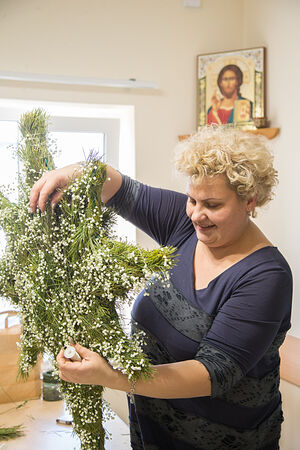 Nowadays, we use modern materials for the floral décor and it allows us to create beautiful elements in harmony with the Orthodox Church design. It is especially true since we have comprehensive resources available to us, such as having a year-round supply of a wide variety of flower material. “The scope of opportunities is perhaps great, but meager finances don’t afford us the rare chance to make use of them,” our skeptical reader may think, assuming that floral design is a sign of luxury. But Yulia Ivanovna knows for sure that if the people had the desire and the skills, anyone could make an inexpensive but elegant composition. To achieve that, you need to plant flowers near the church for their future use in the designs. You can pick up plant material in the fields or ask the parishioners to bring them. But there is one important rule you need to follow: Before using the improvised plant materials in a floral design, you must check how they will last in a vase. There are plants that can bloom for months in the garden or a field, but they won’t last in a vase at all. You should also test whether they can be placed in the floral foam used to create the floral compositions.
Nowadays, we use modern materials for the floral décor and it allows us to create beautiful elements in harmony with the Orthodox Church design. It is especially true since we have comprehensive resources available to us, such as having a year-round supply of a wide variety of flower material. “The scope of opportunities is perhaps great, but meager finances don’t afford us the rare chance to make use of them,” our skeptical reader may think, assuming that floral design is a sign of luxury. But Yulia Ivanovna knows for sure that if the people had the desire and the skills, anyone could make an inexpensive but elegant composition. To achieve that, you need to plant flowers near the church for their future use in the designs. You can pick up plant material in the fields or ask the parishioners to bring them. But there is one important rule you need to follow: Before using the improvised plant materials in a floral design, you must check how they will last in a vase. There are plants that can bloom for months in the garden or a field, but they won’t last in a vase at all. You should also test whether they can be placed in the floral foam used to create the floral compositions.
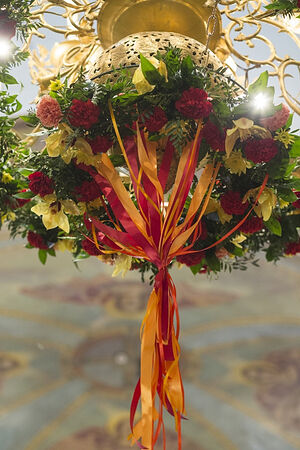 Among the different kinds of greenery, there are lilac branches, peony leaves; thuja, and hosta leaves keep their shape well. The birch tree should have fully formed branches and foliage. If it has light green leaves, they will curl immediately. When selecting flowers, you should cut the ones that built up strength while still in the ground. Bellflowers, sunflowers, zinnias, marigolds, chrysanthemums, asters, hydrangeas, and viburnum berries all hold for a long time. Lilacs do too, provided the flowers were fully opened. Yulia Ivanovna shares an unusual secret: To make the lilac branches last longer, you need to hammer the cut ends of the branches and soften them in boiling water for 2-3 hours.
Among the different kinds of greenery, there are lilac branches, peony leaves; thuja, and hosta leaves keep their shape well. The birch tree should have fully formed branches and foliage. If it has light green leaves, they will curl immediately. When selecting flowers, you should cut the ones that built up strength while still in the ground. Bellflowers, sunflowers, zinnias, marigolds, chrysanthemums, asters, hydrangeas, and viburnum berries all hold for a long time. Lilacs do too, provided the flowers were fully opened. Yulia Ivanovna shares an unusual secret: To make the lilac branches last longer, you need to hammer the cut ends of the branches and soften them in boiling water for 2-3 hours.
On the feast of Pentecost, multi-colored flowers should prevail in the composition; but even then, it should not look chaotic or ill conceived.
“You need to pick a color combination that wouldn't offend the eye. If you have dark burgundy or purple plants (like peonies, for example), we blend in the shades of cream, white, and lemon. The floral designs for Holy Trinity Day should imitate the colors of the native nature of our meadows with its flowers of varying sizes and colors,” notes the expert.
The last bit of Paradise on earth
“Some say the church is boring. It is boring because no one cares for it. That's why it seemingly belongs to others, not ourselves. If only you could bring some flowers or greenery, or take on the burden of decorating the church, it would never seem boring again.”
St. Anatoly of Optina didn’t offer his piece of advice to professional florists or new amateurs, but to all parishioners. For as soon as we take the trouble and do some work, the house of God will become our home as well. A home that is beautiful, cozy, and dear to our heart.
Righteous St. John of Kronstadt called flowers “the last bit of Paradise on earth.” Their beauty is fleeting, but the joy they bring will live on in our hearts, along with the sinking feeling of longing for the Heavenly Fatherland. The desire for beauty and harmony is embedded in our hearts. That is why we present those essentially useless, but truly beautiful flowers to each other as a material representation of our feelings and emotions.
The desire for beauty and harmony is embedded in our hearts
Additionally, each of us, from the point of view of an Orthodox florist, resembles a flower, be it modest or a lush, that makes a composition or adds unique fragrance. Altogether, we create a bouquet of our labors, talents, and most importantly, love of God and people—in short, the Church of Christ.

